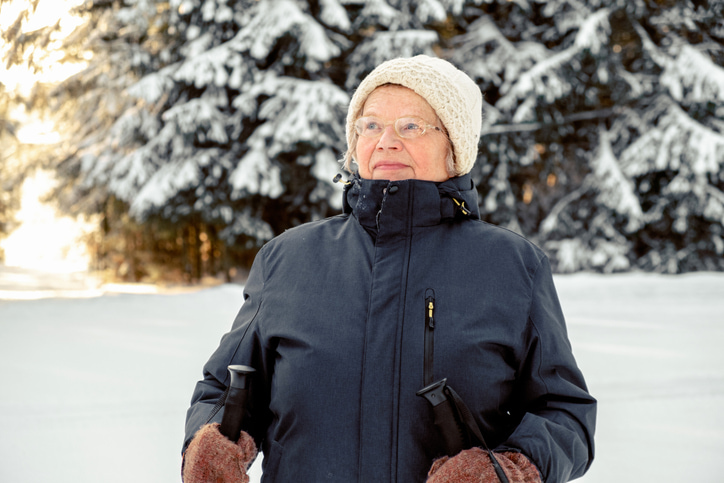As temperatures drop, many of us feel the chill in more ways than one. If you’ve ever noticed your hands and feet getting colder or your legs feeling sluggish during winter, that’s no coincidence. Cold weather can have a direct impact on blood flow, which can be especially concerning for those with vascular conditions. Understanding how the cold affects circulation is key to staying healthy when the mercury dips.
Join the team at The Vascular Care Group as we explore why your body reacts this way and how you can keep your blood flowing smoothly, even in the coldest months.
Why Does Cold Weather Affect Blood Flow?
During cold weather, your body naturally responds by narrowing blood vessels—a process known as vasoconstriction—to conserve heat. While this is an essential survival mechanism, it can have some negative effects on circulation, especially for those who live in cold regions like New England.
Here’s how cold weather affects blood flow:
- Narrowing of Blood Vessels: Blood vessels constrict to minimize heat loss, which reduces the amount of warm blood reaching the skin and extremities. This is why fingers, toes, and ears get cold first.
- Thicker Blood: Cold weather can cause your blood to become denser, increasing the risk of clotting. This is particularly dangerous for individuals with existing vascular conditions like deep vein thrombosis (DVT) or peripheral artery disease (PAD).
- Higher Blood Pressure: As blood vessels tighten, it takes more force to push blood through the body, which can increase blood pressure. This is a concern for those with hypertension or heart conditions.
Signs of Poor Circulation in Cold Weather
Poor circulation is easy to miss but could indicate an underlying vascular problem. Pay close attention to these symptoms, especially during the winter:
- Cold Hands and Feet: Persistent coldness in extremities may signal reduced blood flow.
- Numbness or Tingling: A lack of proper circulation can cause numbness or a “pins and needles” sensation.
- Swelling: In some cases, poor blood flow can lead to swelling, particularly in the legs and ankles.
- Discolored Skin: A bluish tint to fingers or toes could mean your blood isn’t reaching those areas as it should.
If you experience any of these symptoms, especially during winter, it’s important to take them seriously and consult a vascular specialist in your area.
How to Improve Blood Flow During the Winter
Luckily, there are several things you can do to help your circulation during the cold months in New England. Simple lifestyle changes and habits can make a big difference.
Here are some tips for improving blood flow:
- Stay Active: Regular exercise helps promote circulation. Even a brisk walk during your lunch break can get your blood moving.
- Dress Warmly: Wear layers, especially on your hands, feet, and head. Keeping these areas warm helps maintain overall body heat and promotes better circulation.
- Stay Hydrated: Drinking water thins your blood, making it easier for your heart to pump it throughout the body.
- Limit Alcohol Consumption: Alcohol can dilate blood vessels temporarily but may reduce your body’s ability to regulate heat, ultimately making you feel colder.
- Consider Compression Gear: For individuals with circulation problems, wearing compression socks or gloves can help maintain blood flow, especially in colder weather.
Who is Most at Risk?
Certain groups are more vulnerable to poor circulation during colder months. If you fall into any of the following categories, it’s important to be proactive in managing your vascular health:
- Individuals with Diabetes: Diabetes can damage blood vessels over time, making circulation more difficult in colder weather.
- Smokers: Smoking constricts blood vessels, making it harder for your body to circulate blood efficiently, particularly in winter.
- Those with PAD or DVT: Peripheral artery disease and deep vein thrombosis make cold weather particularly risky, as poor circulation can lead to more serious complications.
- Elderly Individuals: As we age, circulation naturally becomes less efficient, and colder temperatures can worsen this problem.
When to See a Vascular Specialist
If you’re experiencing any persistent signs of poor circulation, it’s important to consult with a vascular care provider. Conditions like peripheral artery disease (PAD) and deep vein thrombosis (DVT) can worsen in cold weather, increasing the risk of blood clots, high blood pressure, and other serious complications. A vascular specialist can help diagnose any underlying issues and create a treatment plan tailored to your needs.
Get Expert Vascular Care Across New England
If you’re noticing changes in your circulation this winter, don’t ignore the signs. Schedule an appointment with one of our experienced vascular specialists today. The Vascular Care Group has locations throughout New England, making it easy for you to receive top-notch care no matter where you are.
Let us help you stay healthy and keep your blood flowing smoothly, even in the coldest months.
